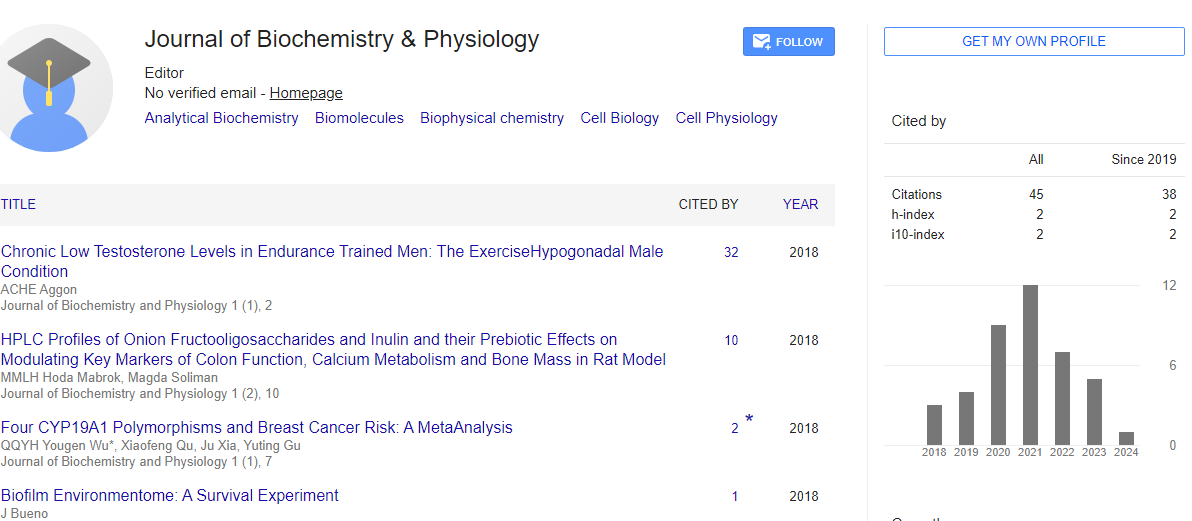Opinion Article, J Biochem Physiol Vol: 7 Issue: 3
Analyzing the Synergy of Chromatography and Mass Spectrometry in Biomarker Discovery
Jack Theo*
1Department of Biochemistry, University of Glasgow, Glasgow, United Kingdom
*Corresponding Author: Jack Theo,
Department of Biochemistry, University of
Glasgow, Glasgow, United Kingdom
E-mail: theo.jack@email.com
Received date: 19 August, 2024, Manuscript No. JBPY-24- 149083;
Editor assigned date: 21 August, 2024, PreQC No. JBPY-24-149083 (PQ);
Reviewed date: 04 September, 2024, QC No. JBPY-24-149083;
Revised date: 12 September, 2024, Manuscript No. JBPY-24-149083 (R);
Published date: 19 September, 2024, DOI: 10.4172/jbpy.1000170.
Citation: Theo J (2024) Analyzing the Synergy of Chromatography and Mass Spectrometry in Biomarker Discovery. J Biochem Physiol 7:3.
Abstract
Description
Biomarker discovery is a critical component of modern medical research, enabling the identification and quantification of biological indicators that can indicate disease progression, response to treatment or susceptibility to conditions. Among the various analytical techniques employed in biomarker research, chromatography and Mass Spectrometry (MS) have emerged as powerful tools that, when combined offer unparalleled sensitivity, specificity and resolution.
Chromatography is a separation technique that depends on the differential partitioning of compounds between a stationary phase and a mobile phase. It enables researchers to isolate and purify individual components from complex biological matrices such as blood, urine or tissue samples. Various chromatographic methods, including Gas Chromatography (GC), Liquid Chromatography (LC) and High- Performance Liquid Chromatography (HPLC), are utilized based on the nature of the sample and the target analytes. For example, LC is particularly effective for separating polar compounds and biomolecules, such as proteins and metabolites, making it essential in metabolomics and proteomics studies.
Mass spectrometry complements chromatography by providing detailed information about the molecular weight, structure and abundance of the separated compounds. In mass spectrometry, ionization techniques generate charged particles from analytes, which are then analyzed based on their mass-to-charge ratio. This allows for the identification of compounds and their quantification in a sample. The coupling of chromatography with mass spectrometry (often referred to as LC-MS or GC-MS) enhances the overall analytical capability, enabling the simultaneous separation and identification of multiple biomarkers within a single run.
One of the most significant advantages of the chromatographicmass spectrometric approach is its ability to analyze complex biological samples with high sensitivity and specificity. For instance, in the context of cancer biomarker discovery, the simultaneous detection of low-abundance metabolites and proteins can provide insights into the metabolic changes associated with tumor development and progression. Researchers can utilize LC-MS to separate metabolites from serum samples, identify potential biomarkers through spectral analysis and correlate these findings with clinical outcomes, thereby facilitating the identification of diagnostic or prognostic markers.
The integration of chromatography and mass spectrometry has also been bolstered by technological advancements. The development of high-resolution mass spectrometers, such as Orbitrap and Time-of- Flight (TOF) instruments, has significantly improved the sensitivity and accuracy of mass measurements. Additionally, advancements in chromatographic techniques, such as Ultra-High-Performance Liquid Chromatography (UHPLC), allow for faster separation times and enhanced resolution of analytes. These innovations enable researchers to achieve more comprehensive profiling of biological samples, uncovering novel biomarkers that may have been previously overlooked.
Conclusion
The synergy of chromatography and mass spectrometry represents a powerful alliance in the field of biomarker discovery. Together, these techniques enable researchers to navigate the complexities of biological samples with exceptional care, sensitivity and specificity. This synergy not only develop the scientific landscape but also holds promise for improving patient outcomes through the identification and application of meaningful biomarkers in clinical practice.
 Spanish
Spanish  Chinese
Chinese  Russian
Russian  German
German  French
French  Japanese
Japanese  Portuguese
Portuguese  Hindi
Hindi 